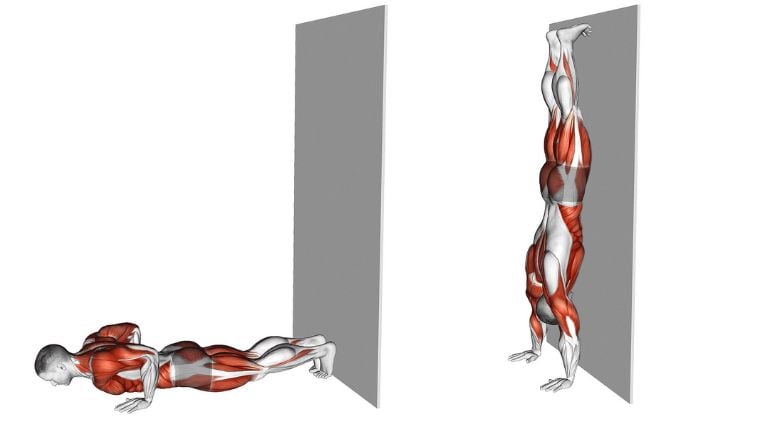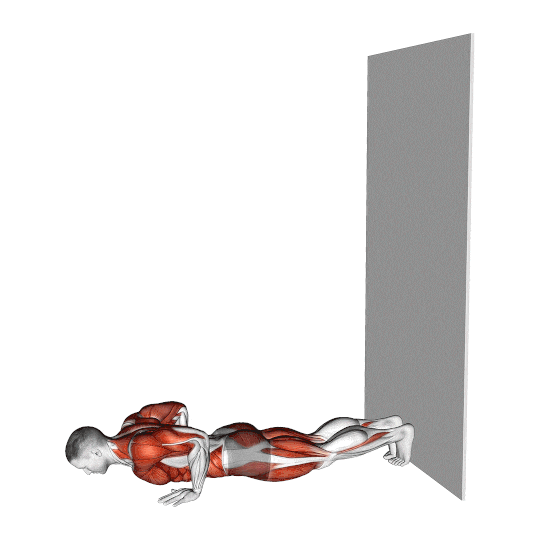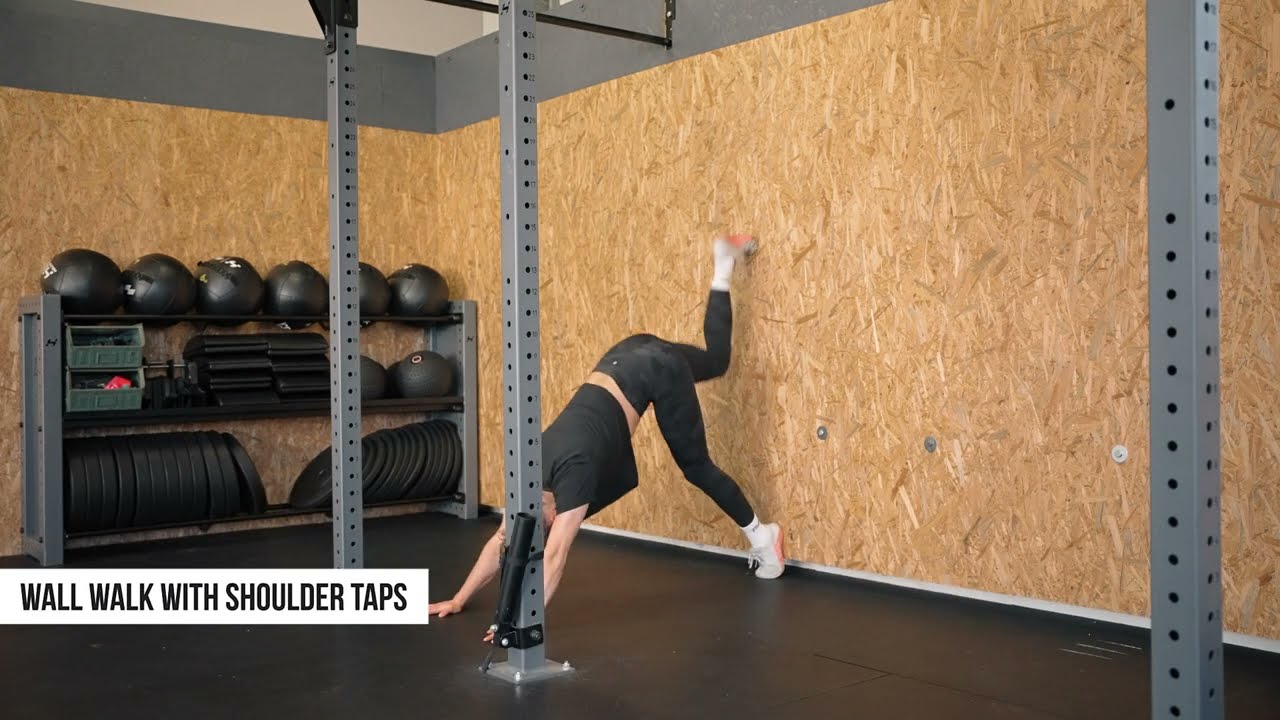The Wall Walk, also called the Wall Climb, is a bodyweight workout that works all your body parts. It helps you build strength, stability, and coordination in your upper and lower bodies. This dual demand improves neuromuscular coordination and enhances body awareness and control.
Unlike more common bodyweight exercises, the Wall Walk offers a unique blend of strength training and mobility work that targets several muscle groups simultaneously.
Wall climbs work several muscles in the upper body, including the shoulders, chest, triceps, and upper back, as well as the core muscles, including the abs and lower back.
Wall walks are a great way to break up your regular workout, whether you’re a CrossFit enthusiast, a gymnast, or someone who just wants to do something different.
This exercise is known for overcoming gravity and improving your strength, balance, and core stability.
Want to take your gains to the next level? Discover your daily calorie needs with our free TDEE calculator

- Wall Walk Muscles Worked
- How To Do Wall Walks
- Tips and Form
- Walk Walks Modifications and Variations
- 1. Half Wall Walks
- 2. Wall Walks With a Push-up
- 3. Wall Walks with a Shoulder Tap
- Why You Should Do Wall Walks
- 1. Full-Body Workout
- 2. Improves Balance and Stability
- 3. Enhances Functional Strength
- 4. Increased upper body strength
- 5. Improve Overall Health
Wall Walk Muscles Worked
Wall walks are a multi-joint, compound exercise that targets a broad spectrum of muscle groups. They require strength in the upper body, stability in the core, and control in the lower body.
- Primary Muscles Worked: Shoulders (Deltoids), Chest, Upper Back, Triceps and Core Muscles.
- Secondary and Stabilizers Muscles Worked: Forearms, Glutes and Hamstrings, Calves, Lower Back (Erector Spinae) and Serratus Anterior

How To Do Wall Walks

- Start in a high plank position with your feet against the wall and your hands shoulder-width apart on the floor.
- Press your toes into the wall, lifting one foot at a time to place them against it.
- Engage your core and stabilize your upper body to prepare for the climb.
- Slowly start to “walk” your feet up the wall while moving your hands toward the wall as well.
- Keep your body straight as possible, engage your core, and maintain a tight line from head to toe.
- Once your feet are up the wall and your hands are close to it, you should be in a handstand-like position.
- Pause for a moment to stabilize your position.
- Start walking your feet back down the wall, while simultaneously moving your hands away from the wall.
- Take your feet off the wall and return to the starting plank position.
- The above will complete 1 repetition of a wall climb.
Tips and Form
- Actively engage the core throughout the exercise for better stability.
- Slowly begin walking your feet up the wall, one step at a time, while simultaneously walking your hands backward toward the wall. Moving too quickly leads to loss of form and balance.
- Keep your shoulders stacked directly over your hands and your body in a straight line. Avoid letting your lower back arch or your hips sag.
- Keep your hands shoulder-width apart and your feet close together against the wall. This positioning provides a stable base and helps distribute your body weight evenly
- Keep your neck in a neutral position, neither looking up nor tucking your chin excessively.
- Warm up your shoulders, wrists, and core before attempting Wall Walks.
- If you’re new to the exercise, have a spotter nearby.
Walk Walks Modifications and Variations
Since the Wall Walk can be scaled in difficulty (by adjusting how far up the wall you go), it’s a great exercise for progressive overload.
Beginners can start by walking only partway up the wall, while more advanced athletes can aim to reach full handstand positions or add shoulder taps.
Here are some modifications and variations you can try.
1. Half Wall Walks
This is a simplified version of the full Wall Walk, which is ideal for beginners.
It’s easier on the shoulders and doesn’t require as much core strength, so it’s easy for people new to the exercise.
Instead of walking all the way up to a handstand position, stop midway. Then, walk back down to your starting position.
2. Wall Walks With a Push-up
This variation adds a push-up at the beginning or end of the Wall Walk. It makes exercise more challenging and effective for a full-body workout.
Start in a plank position. Perform a push-up, then immediately proceed to do a Wall Walk. Alternatively, you can add the push-up after you come down from the Wall Walk before resetting to the starting position.
3. Wall Walks with a Shoulder Tap
The shoulder tap at the top of this variation challenges your shoulders and core.
The exercise is more challenging because it enhances shoulder stability and engages the core more intensively.
How To Do It
- Start in a push-up position with your feet against the wall.
- Then, walk your hands and feet up the wall until you reach a comfortable height.
- At the top of the wall, tap your right shoulder with your left hand.
- Repeat on the other side before walking back down.
- Then, walk back down the wall to the starting position.
Why You Should Do Wall Walks
Wall walks are versatile movements with various benefits. Here are some reasons to include them in your regular exercise routine.
1. Full-Body Workout
One of the most compelling reasons to do Wall Walks is that they work multiple muscle groups at once. Unlike isolated exercises focusing on one specific area, Wall Walks demand coordination and strength from your entire body.
To execute this exercise effectively, your shoulders, back, chest, arms, and core must work in harmony.
2. Improves Balance and Stability
Balance isn’t just about standing on one foot; it’s about the ability to control your body through complex movements. Wall Walks demand high balance and coordination as you “walk” up and down the wall.
This can significantly improve your proprioception and your body’s sense of positioning in space. It will also improve your overall balance and stability.
3. Enhances Functional Strength
Functional strength refers to the type of strength that applies to real-world situations.
Wall Walks are more than just lifting heavy weights in a controlled environment. They also help you build strength in your upper body and core for everyday activities and sports.
4. Increased upper body strength
Wall climbs work the shoulders, upper back, chest, and triceps muscles, strengthening the upper body. It is important to remember that wall climbs engage the core muscles, including the abs and lower back, which can help improve core strength.
5. Improve Overall Health
A recent analysis found isometric exercises to be highly effective for lowering blood pressure. Isometric exercises involve contracting muscles without moving joints, like planks, wall sits, and walking climbs.
Holding an exercise position statically can be a simple yet powerful way to improve cardiovascular health.
I hope this guide helped you understand how to perform wall walks safely and correctly. Add them to your workouts to improve your physical fitness.
Please let me know if you have any other questions.

Manish is a NASM-certified fitness and nutrition coach with over 10 years of experience in weight lifting and fat loss fitness coaching. He specializes in gym-based training and has a lot of knowledge about exercise, lifting technique, biomechanics, and more.
Through “Fit Life Regime,” he generously shares the insights he’s gained over a decade in the field. His goal is to equip others with the knowledge to start their own fitness journey.


